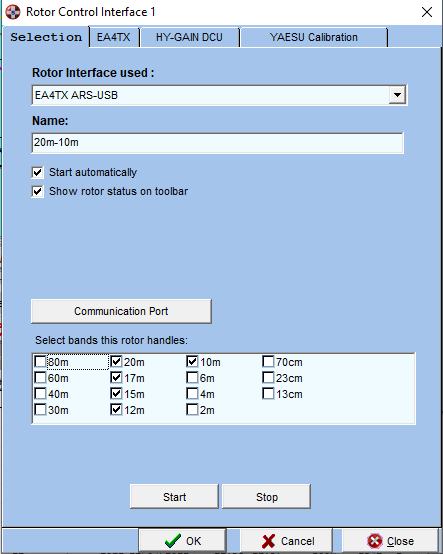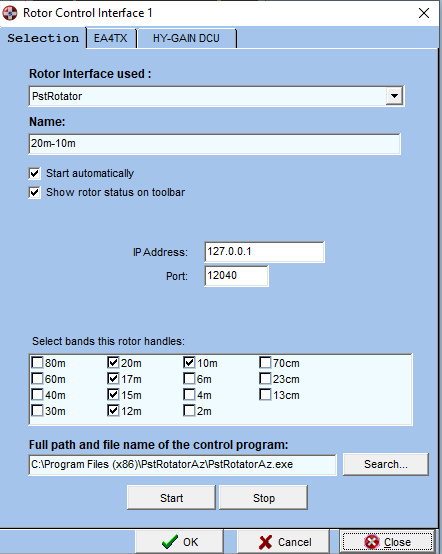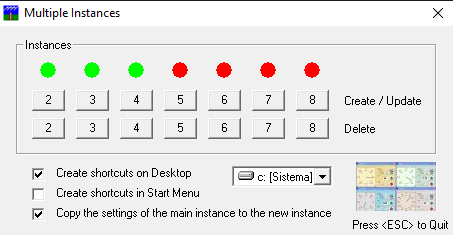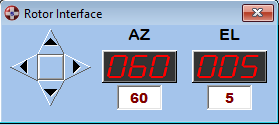
Rotor-Interface
You can configure up to 4 different rotor interfaces and switch between them easily. SWISSLOG supports the following Rotor Interfaces:
Select Option ¦ Rotor interface > Rotor 1 from the main menu (repeat for rotor 2, 3 and 4 when needed). The following dialog is displayed:

- If Rotor supports manual operation you can turn rotor by clicking on the Arrows keys. If rotor is turning, you can stop rotor by clicking on the Arrows keys again.
- If you have configured more than one rotor, click on the Rotor label to switch rotor in the following sequence: Rotor 1 > Rotor 2 > Rotor 3 > Rotor 4. Place your mouse pointer over the Rotor label to display a hint with the name assigned to the current rotor and the name of the next rotor.
NOTE: You can also enter the end position manually and press Enter.
Some Rotor Interfaces are directly controlled via a Com-Port. Press this button to select the Com-Port and set the Speed an other options.
Check which bands are handled by this rotor (none checked = ALL bands). The "Turn antenna" function implemented in the QSO Entry, DX Cluster windows or Band Maps will only work if transceiver is tuned in any of the selected bands (transceiver control must be started).
IMPORTANT: If you have configured more than 1 rotor, Swisslog provides a very useful feature: it will automatically select the corresponding rotor according the band tuned on your transceiver! You only need to set the bands supported by each rotor and the transceiver control must be configured and started.
For some Interfaces you need software drivers or programs provided by the manufacturer of the Rotor. Enter the location of the program in this field or press the Search button. (i.e.: ARSWIN.EXE for EA4TX ARS-LPT, LPROTOR.EXE for LP-Rotor, PSTROTATOR.EXE or PSTROTATORAZ.EXE for PSTRotator, etc).
Start: press this button to start the communication with the rotor.
Stop: press this button to stop the communication with the rotor.
PstRotator is available in 2 versions (Swisslog supports both versions):
You can handle up to 4 rotors (4 program instances working at once).

Set a comprehensive and short name to this rotor
Leave IP Adrress and Port to the default values (127.0.0.1 and 12040 respectively).
Check the bands handled by this rotor
Select the PstRotatorAz.exe (or PstRotator.exe if you have the azimuth + elevation version) from the corresponding folder by means of the Search button
Press Start to save settings and start the rotor interface
First of all, configure Rotor 1 as described in the previous section.
Open PstRotatorAz (or PstRotator) and go to Help > Multiple Instances
Select the drive unit where you want to create the new instance(s). I suggest you to check the "Copy the settings of the main instance to the new instance". This way all instances will have the same configuration as set in main instance, saving you a lot of time.
Create as many instances as rotors you want to configure by pressing the corresponding button in the Create / Update row.

PstRotator will automatically create a folder called PstRotatorAz + n (or PstRotator + n) in the select drive, where n is the instance number (i.e. C:\PstRotatorAz2, C:\PstRotatorAz3, C:\PstRotator2, C:\PstRotator3, etc.). You will find a shorcut for every new instance in your desktop. Close this window.
Repeat the following steps for every new instance:
Open instance 2, called PstRotatorAz2 (or Pstrotator2). This will be Rotor 2 in Swisslog!
Go to Setup > Trackers setup > Swisslog setup
Set the Ethernet Port number to 12042. NOTE: Port 12040 is the default port used in the main instance (Rotor 1). Set 12044 for Rotor 3 and 12046 for Rotor 4.
Press the Save settings button.
I suggest you to set a customized title for every instance: Go to Setup > Label and set a name. For instance: Rotor 2 - 40m dipole., Rotor 3 - 20-10m 3 el. Yagi, etc. Hint: Add blanks at the end of your text to only see your title and avoid displaying "PstRotator registered to...".
Repeat the steps above for Rotor 3 and Rotor 4 changing the instance number accordingly.
Repeat these steps for every instance:
In Swisslog go to Options / Rotor interface > Rotor 2
Set a comprehensive and short name to this rotor
Swisslog will set the following default ports according the selected Rotor: 12042 for Rotor 2, 12044 for Rotor 3 and 12046 for Rotor 4.
Check the bands handled by this rotor. This is very important to do if you want Swisslog selects the corresponding rotor automatically when changing bands on the transceiver (transceiver control must be started).
Select the PstRotatorAz2.exe (or PstRotator2.exe if you have the azimuth + elevation version) by means of the Search button (you will find this file in the corresponding folder created by every instance).
Press Start to save settings and start the rotor interface
Repeat the steps above for Rotor 3 and Rotor 4 on the corresponding Rotor configuration number if you created these PstRotator instances.
A small window is available which allows you to control manually the currently selected Rotor. From the main menu select View ¦ Rotor-Interface :

If the Rotor supports also Elevation you can also control the vertical rotor. Press on the direction button to start the motion in the corresponding direction. Press the center button to stop the motion. You can also enter the end position manually in the azimuth/elevation fields and press Enter to turn. Window can be set as standalone via pop-up menu.
A window is available as azimuth indicator. It's resizable and it offers different features whether a rotor interface is used or not. From the main menu select View | Azimuth Indicator.
If using a rotor interface it has the following features:
It will look like this:
If no rotor interface is used, it will display the bearing of the current station entered in the QSO Entry window. The window title will display the azimuth and also the long path bearing:
Copyright © 2004 SWISSLOG
Last modified:
19 ene. 2024